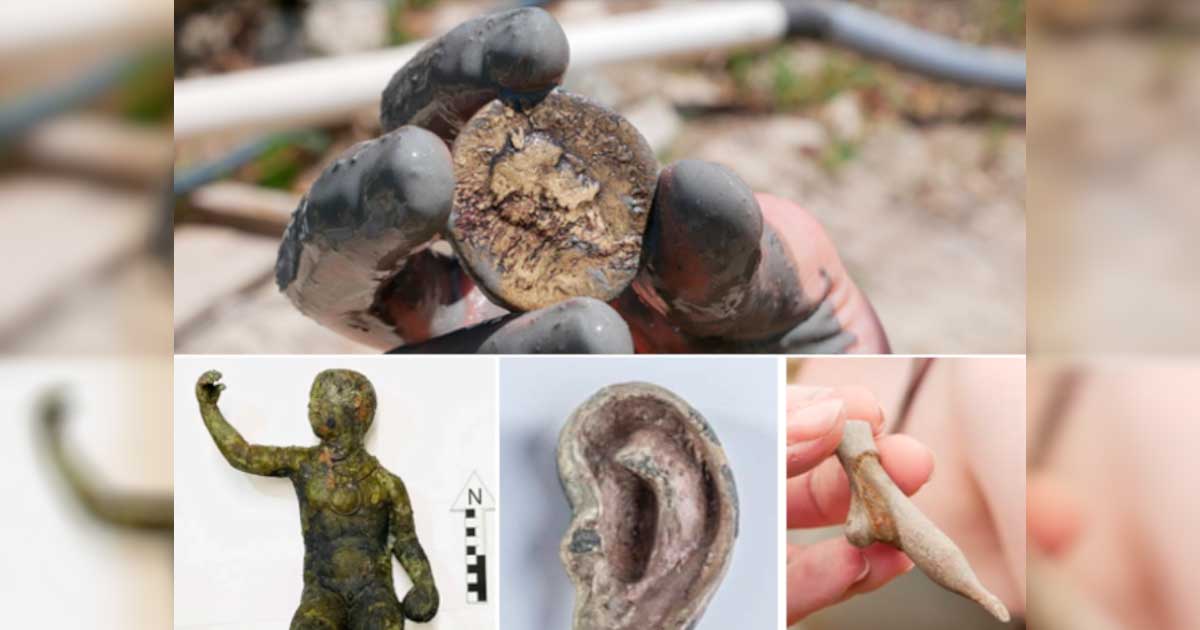It’s amazing what treasures people will throw away in the hope of winning the favor of the gods. Rare items used as votive offerings found in an “exceptional state of preservation” have been discovered at the celebrated San Casciano dei Bagni Etruscan baths in Tuscany, Italy. Archaeologists working at this thermal spring complex which developed in the 4th century BC, have discovered a treasure trove of votive offerings, coins, and stone carvings.

Votive Offerings, Coins, and Symbols of Fertility
In addition to the rare ancient votive offerings found at the Tuscany site, 3,000 ancient coins, of which a fourth are freshly minted and still shiny, have also been found, reports CNN. These coins, made of gold, silver, orichalcum, and bronze, have been dated to the reigns of Augustus, the Flavian emperors, Trajan, Hadrian, and Marcus Aurelius. Orichalcum coins, a valuable yellow alloy of gold and copper prized by the ancient Greeks and Romans, were found in the biggest bath.

Coins, made of gold, silver, orichalcum, and bronze, have been dated to the reigns of Augustus, the Flavian emperors, Trajan, Hadrian, and Marcus Aurelius. (Emanuele Mariotti / SABAP-SI)
The Tuscany find is the largest ancient currency haul found at any of the thermal springs in the Mediterranean. And nearly everything discovered was found in a near-perfect state of preservation, including original colors. This excellent state of preservation was the result of the water’s chemical properties and the lack of oxygen in the mud layers at bottom of the pools.
“They’re still shiny brown and shiny yellow — such bright colors have never been found in any excavation site,” said archaeologist Jacopo Tabolli, scientific director of the excavation project and professor of Etruscan studies at Siena’s University for Foreigners. He further described it as “a miracle.”

Three ear-shaped votive offerings unearthed at the San Casciano dei Bagni thermal dig site, Tuscany, Italy. (Emanuele Mariotti / SABAP-SI)
A marble relief of a bull’s head, a bronze putto, five bronze votive offerings, miniature lamps, a bronze foil belt, and other religious offerings were also found. And these finds really added a sense of triumph for the archaeologists that have worked at the site for six dig seasons over the past three years.
“What makes this site unique in the entire Mediterranean is the exceptional state of preservation, and the [evidence] it provides for how medical hot water practices were considered curative under divine protection . . . The amount and quality of the objects recovered are also astonishing — we knew something was down there but weren’t expecting such a surprise,” stated Tabolli.
A womb made of bronze called a unicum, another reference to fertility, was one of the highlights of the finds made over the last two weeks. It has been dated to the end of the Roman Republic and the beginning of the Roman Empire.
This fertility worship and gifting of votive offerings at thermal baths was still practiced in Italy as recently as 50 years ago! Village women who had trouble conceiving would come to the thermal springs hoping that the therapeutic powers of the water would help their womb relax.
The other highlight discovery were “footprints” found on the surface of a holy basin, etched with traces of lead and silver. These footprints, of different sizes, were made with sandals worn by children, teenagers, and adults. Bull hooves and human ears, associated with Isis and Serapis, were also found here. Archaeologists speculate the votive offering process included devotees walking around the perimeter of the pools to ask for good health and wellbeing from these gods.

An aerial view of the San Casciano dei Bagni thermal spring site where the recent finds were made. (Municipality of San Casciano dei Bagni)
The Etruscans and the Romans: Faith in Healing Thermal Baths
The votive offerings have been dated to the Etruscans, who were the predecessors of the Romans in this region. A lot of cultural practices, including rituals related with fertility, death, and worship, were borrowed from the Etruscans by the polytheistic Romans. The Etruscans also “taught” the Romans the health benefits and pleasure of bathing.
The Etruscans favored this part of Tuscany because of the water’s healing properties from its rich concentrations of calcium, magnesium, chloride, and sulfates. The Romans would later make most Etruscan thermal spring complexes larger and more lavish.
“The discoveries tell us a lot about Italy’s ancient communities and advance our research on their social, cultural and religious landscape with regard to the sacred nature of hot water,” said Tabolli.
The San Casciano dei Bagni bath complex, under the Romans, became a wealthy religious sanctuary, and a flourishing thermal resort . In its heyday, the pools bubbling with natural hot therapeutic water, must have been a visually diverse scene. The baths included breath-taking scenery on all four sides, with different altitudes and topography, fountains, colonnades, and water features. This is why thermal bath tourism is still a key industry for this small Tuscan hamlet.
From their research, Tabolli and his colleagues have gleaned that the ancient thermal baths functioned like a hospital clinic. These “clinics” attracted those with fertility issues, but also people seeking help for respiratory problems, joint aches, and pains. After the healing process, they’d throw their “personal” votive offerings to the gods in gratification, which ranged from tree branches and pine cones to expensive metal crafted body parts.
A new village museum will showcase these finds, and the archaeologists expect to find more to add to this bourgeoning collection. “I hope to unearth the founding sanctuary in its entirety. We can already spot a pre-Roman layer,” Tabolli concluded.